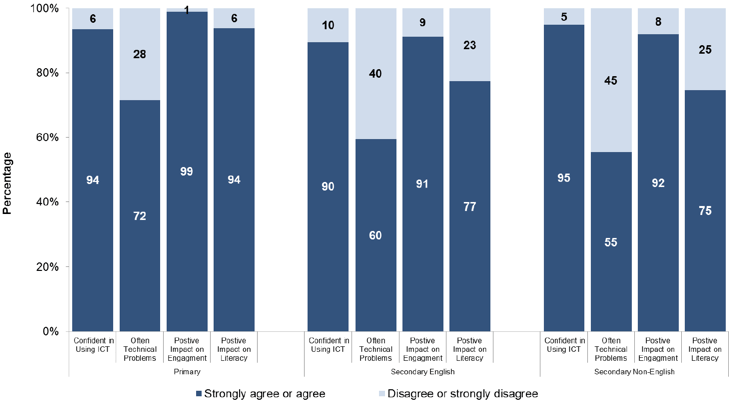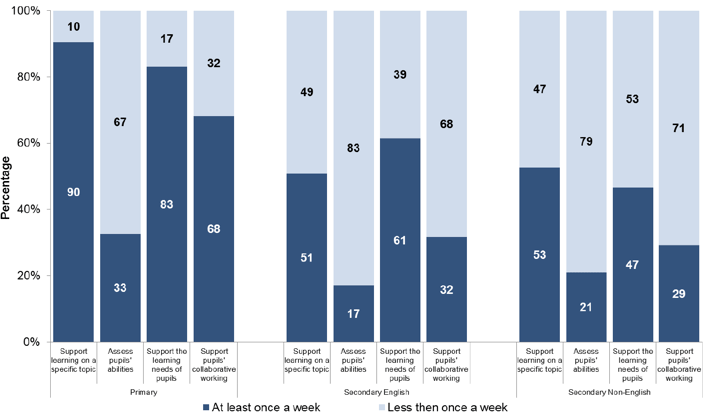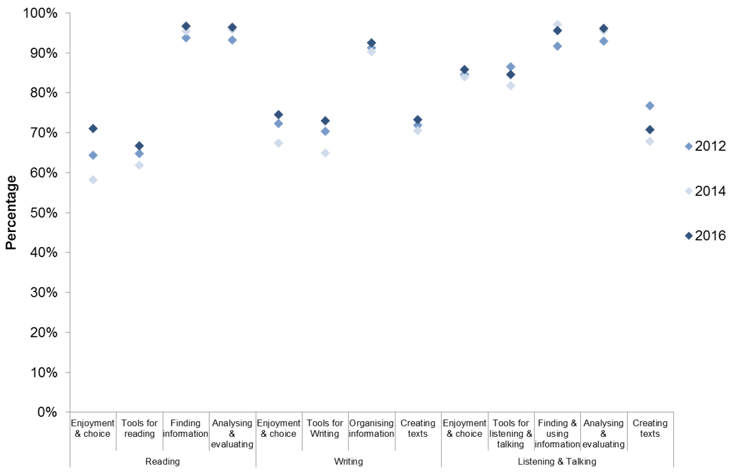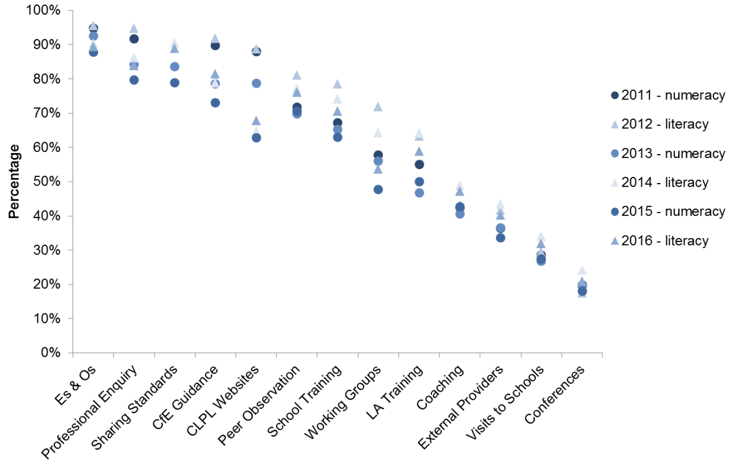Scottish Survey of Literacy and Numeracy 2016: literacy
Literacy results from the 2016 survey which covers assessment of school pupils at various stages in primary and secondary school.
Chapter 9: Teacher questionnaire
- Teachers reported that pupils work collaboratively in class, often working in groups and discussing what they are learning, as well as working on their own or being taught with the class as a whole.
- Teachers are confident in their ability to use ICT and believe it has a positive impact on literacy.
- Primary and secondary English teachers are confident in delivering the CfE literacy experiences and outcomes .
The teacher questionnaire was distributed to all P4 class teachers in half of participating primary schools and all P7 teachers in the remaining half of primary schools. In secondary schools, questionnaires were given to ten teachers in each school: two S2 English teachers and two S2 teachers from each of four broad curriculum groupings:
- Mathematics, Science and Technology
- Social Studies, Religious and Moral Education ( RME) and Health & Wellbeing
- Expressive Arts and Languages
- Support for Learning (SfL).
Primary and secondary non-English questionnaires focused on one of reading, writing or listening and talking, whereas secondary English questionnaires covered all three literacy organisers.
9.1 Classroom activities and resources
Teachers were asked how often pupils in their classes spend time doing a range of activities. The results for primary teachers showed little variation across all six survey years. In each year at least 70 per cent of teachers reported that on most days pupils 'worked quietly on their own' or 'talked about what they are learning in pairs/groups' or 'were taught with the whole class together'. These were consistently the three most common activities. Pupils were least likely to 'give a talk to the class or a small group', 'work outside the classroom' or 'watch or talk about videos/ DVDs'. Fewer than 10 per cent of primary teachers reported that pupils did these activities on most days in any year from 2011 to 2016.
Results for secondary English teachers show similar results with over 90 per cent of respondents reporting that on most days pupils 'worked quietly on their own', 'were taught with the whole class together' or 'talked about what they are learning in pairs/groups'. There was little change in the reported classroom activities over the three cycles of the literacy survey (2012, 2014, and 2016). However one activity did change markedly in that time; in 2012, 53 per cent of secondary English teachers reported that textbooks were used 'most days/most weeks' which fell to just 34 per cent in 2016. The same result did not apply to secondary Maths teachers with 96 per cent reporting use of textbooks 'most days/most weeks' in 2011, which is statistically similar to the 2015 figure of 94 per cent.
Teachers were also asked about the resources they used when focusing on literacy in 2012, 2014 and 2016 (or numeracy in 2011, 2013 and 2015). For primary teachers, the resources used most often were very similar across all years and across both literacy and numeracy. They included 'Curriculum for Excellence experiences and outcomes', 'interactive whiteboards' and 'materials you have developed yourself'. In all cases over 90 per cent of teachers reported using these resources every day, most days or most weeks.
There was a difference in the use of commercially produced materials; when focusing on numeracy over 97 per cent of primary teachers used these every day, most days or most weeks but when focusing on literacy that dropped by around 10 percentage points. This difference becomes even more pronounced in secondary school; over 95 per cent of secondary Maths teachers used commercially produced materials every day, most days or most weeks compared to less than half of secondary English teachers in each year for which data is available.
9.2 Teachers use of ICT
Teachers were asked about their use of and opinions on ICT. Chart 9.1 shows that in 2016 large proportions (over 90 per cent) of primary and secondary teachers expressed confidence in their abilities to use ICT in class. They were also confident that its use had a positive impact on pupils engagement in their learning and on their literacy skills. However, more than half of secondary teachers agree that there are often technical problems with ICT equipment available in class. This rises to over 70 per cent for primary teachers.
Chart 9.1: Teachers opinions on ICT by teacher type, 2016

The use made of ICT varies by teacher type; the 2016 survey shows 90 per cent of primary teachers use ICT to support learning of a specific topic at least once a week compared to around 50 per cent for secondary teachers. Primary teachers are more likely to use ICT to support pupils' collaborative work at least once a week (two-thirds) than secondary teachers (around a third).
Using ICT to assess pupils' abilities is less common across all teacher types. A third of primary teachers use ICT to assess their pupils abilities at least once a week. This falls to around a fifth for secondary non-English teachers and a sixth for secondary English teachers.
Chart 9.2: Teachers use of ICT by teacher type, 2016

9.3 Teaching literacy across the curriculum
Teachers were asked about their confidence in teaching the literacy experiences and outcomes. Primary and secondary English teachers expressed high levels of confidence in teaching all of them. The confidence of secondary non-English teachers varied by outcome (Chart 9.3). They consistently showed confidence in teaching 'finding and using information' and 'understanding, analysing and evaluating' for reading. Similarly they were confident in 'finding and using information' for listening and talking. There were also increases in the confidence expressed in teaching all three of these outcomes between 2012 and 2016.
Chart 9.3: Secondary non-English teachers confidence in delivering literacy experiences and outcomes, 2012, 2014 and 2016

9.4 Professional development
Teachers were asked how often they had taken part in various forms of Career-Long Professional Learning ( CLPL) in the last twelve months and, if they had, how useful they had found it. The CLPL related to literacy and numeracy experiences and outcomes only.
Chart 9.4 shows that the activities that primary teachers participate in have varied little over the six years of the survey. The top three activities have consistently been 'reading and discussing the CfE experiences and outcomes with colleagues', 'professional enquiry through reading/personal study' and 'sharing standards and moderation' (only asked from 2013 onwards). However, the spread over the six years for each of these activities varies. The proportion of teachers who participated in 'professional enquiry through reading/personal study' ranged from 80 per cent in 2015 to 95 per cent in 2012. Whereas 'reading and discussing the CfE literacy/numeracy experiences and outcomes with colleagues' ranged from 88 per cent in 2015 to 96 per cent in 2012.
For secondary teachers there are very similar results. Across all six years and all four groups of secondary teachers (Maths and non-Maths in 2011, 2013 and 2015; English and non-English in 2012, 2014 and 2016) the same three activities are identified as the most common CLPL activities.
Chart 9.4: Proportion of primary teachers participating in CLPL activity in literacy/numeracy in last twelve months, 2011-2016

Contact
Email: Marion MacRury
Phone: 0300 244 4000 – Central Enquiry Unit
The Scottish Government
St Andrew's House
Regent Road
Edinburgh
EH1 3DG
There is a problem
Thanks for your feedback